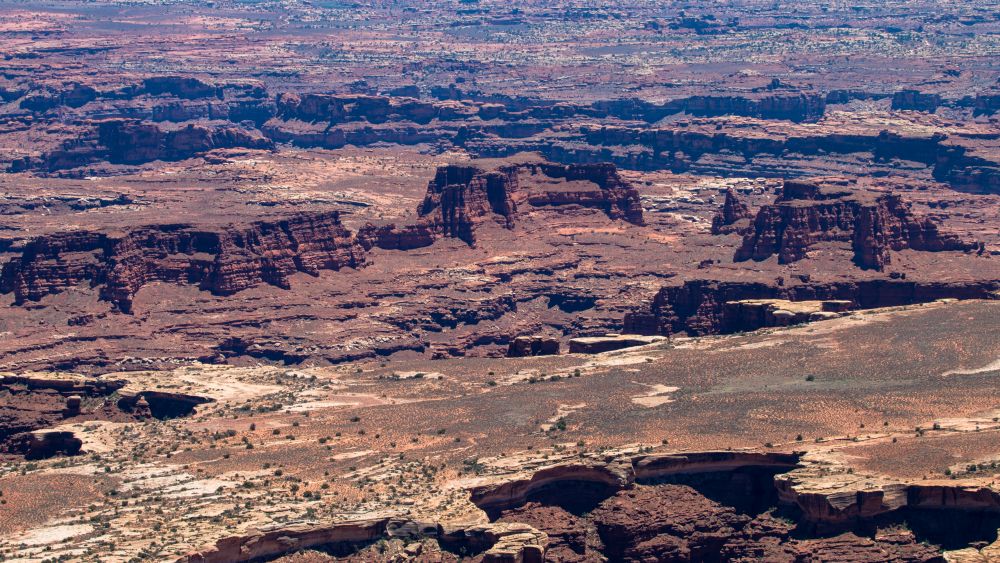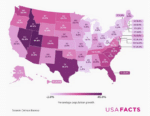
Utah’s Public Land Ruling and Its Implications
- NPG
- February 10, 2025
- NPG Commentary
- 0 Comments
How Federal Land Disputes Reflect Broader Growth Issues

Recently, the U.S. Supreme Court rejected Utah’s legal challenge to federal control over 18.5 million acres of public land. This decision has sparked discussions about the balance between resource management and population growth pressures, particularly in states like Utah, where federal lands make up nearly 70% of the territory.
This debate also underscores a larger issue—rapid U.S. population growth, primarily driven by immigration, that intensifies resource demands at both state and federal levels. More people mean increased competition for jobs, infrastructure, housing, energy, and natural resources. Population pressures force states like Utah to seek expanded access to land.
Much of Utah’s land is federally owned, which significantly limits the state’s ability to independently manage resources and economic development. This dynamic has sparked long-standing tensions between state leaders and federal authorities, who are often at odds about how public lands should be used and managed. The growing population exacerbates resource demands, adding further pressure on the state to find sustainable solutions.
Efforts to assert greater state control over federal lands, such as those championed during the “Sagebrush Rebellion” of the 1970s and 1980s, are deeply rooted in Utah’s political history. Proponents argue that local control would promote economic growth and grant the state more flexibility to meet the needs of its residents. However, this push reflects broader national debates over how to balance the demands of population growth with environmental conservation and responsible land use, leaving Utah at the forefront of these contentious discussions.
*****
Some states have successfully acquired control of federal lands through federal land transfers, though these cases are relatively limited in scope. Most often, such transfers occur under specific agreements or laws, and the outcomes vary depending on how the states manage the land.
State access to federal land has had profound implications across regions. For example, Florida gained control of wetlands like the Everglades, but extensive drainage efforts caused lasting ecological damage. While restoration initiatives have improved water quality and habitats, significant environmental challenges persist. Similarly, when Hawaii achieved statehood in 1959, it obtained 1.4 million acres of federal land, intended to benefit Native Hawaiians and the public. Despite improving infrastructure and creating housing programs, management of these lands has faced criticism for inefficiencies and inequities, leaving many Native Hawaiians frustrated with unmet promises. These examples illustrate the complex, often contentious nature of state stewardship over federally transferred lands.
Alaska and Nevada offer further examples of the challenges associated with state control of federally transferred lands. Upon achieving statehood in 1959, Alaska was granted over 100 million acres of federal land, intended to support economic development and public services. While this land transfer contributed to resource extraction industries and infrastructure growth, it also sparked significant conflicts involving environmental conservation and the rights of Indigenous peoples. Critics argue that the state’s policies have sometimes prioritized economic gains over ecological and cultural preservation, leading to tensions that remain unresolved.
Similarly, Nevada’s relationship with federal land has been fraught with controversy. Although the state received relatively limited land during its admission to the Union, nearly 85% of Nevada’s total land area remains under federal ownership. This has fueled ongoing debates over state sovereignty, land use policies, and access to natural resources. Efforts to expand state control have been met with resistance from environmental groups and federal agencies, highlighting the complexities of balancing economic development with conservation imperatives. Both Alaska and Nevada exemplify the intricate dynamics and competing priorities that characterize state-federal land management arrangements.
*****
Historically, Did Federal Land Transfers Improve Residents’ Lives?
-
-
- Economic Gains: In many cases, resource extraction or land sales funded public services, infrastructure, and education. States like Alaska and Nevada used revenues from land development to directly or indirectly benefit residents.
- Environmental Challenges: Land development often causes ecological degradation, leading to long-term consequences (e.g., water scarcity in Nevada, Everglades damage in Florida).
- Equity Issues: Not all residents benefited equally. For example, Native Hawaiians have criticized the mismanagement of their lands, and rural communities in states like Nevada have felt left out of land sale benefits.
- Sustainability Concerns: Many states face the challenge of balancing economic development with environmental preservation, as population growth can lead to resource depletion and ecological damage.
-
*****
Conclusion
These examples show that state control over federal land can bring economic opportunities but also carries significant risks. Success depends on how effectively a state balances development, conservation, and equitable access to resources. States that prioritize sustainable practices and equitable policies are more likely to achieve long-term benefits for their residents while mitigating ecological and social harm. NPG’s mission to address immigration-fueled population growth is critical to reducing these stressors. By advocating for stricter immigration policies and lower population levels, we aim to protect public lands—and Americans—from exploitation.
NPG will soon publish a state profile for Utah, to be included in our popular State Profile Series.
Through your continued support and donations to NPG, we can advocate for these necessary changes.
Make a Difference – Donate Now


